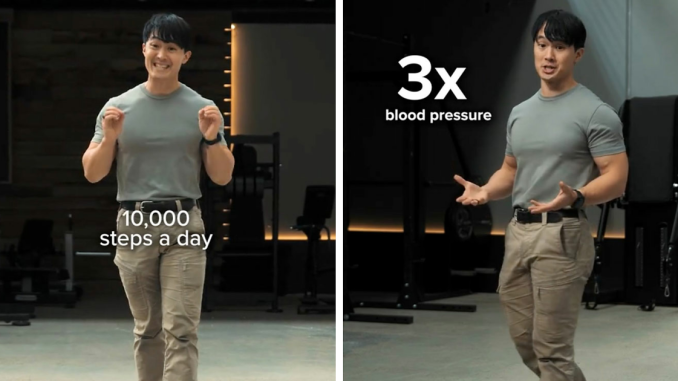
The fix-all 10,000 steps per day method credited with longevity and healthy aging has been bettered by a surprisingly easier fitness hack.
Strength coach Eugene Teo recently took to TikTok with a strategy that takes a fraction of the time and produces better results.
“If you’re short on time or want to get the most bang for your buck, this is for you,” Teo said in the video.
The strategy, notably, follows a study that indicated nearly half of Americans want to train but just do not have the time.
The new hack is based on science and research
Image credits: Dave Goudreau
In the 39-second video, Teo opens with: “You probably heard that you should walk 10,000 steps a day.”
He goes on to reference a 2007 study by Japanese researchers at the island state’s Shinshu University. They discovered a walking technique that offers ten times the benefits in just 30 minutes.
The study leading up to the finding entailed 246 63-year-olds divided into three groups.
Image credits: coacheugeneteo
One subset was left to a sedentary lifestyle with no walking at all, while the second was signed up for the popularized step regime and told to take around 8,000 steps daily, no less than four times a week.
The last group was given a special regime that took up 30 minutes of their schedule for the same number of days weekly.
The new hack uses less time to accomplish more
Image credits: coacheugeneteo
In these thirty minutes, the subjects had to alternate between three minutes of fast walking and three minutes of slow walking—a strategy now known as interval walking.
The researchers found that the progress made by this last group outweighed that of the sedentary first group and, counterintuitively, that of the second group, too—even though they racked up close to 30,000 steps weekly.
Image credits: coacheugeneteo
The third group showed improved blood pressure and glucose levels, and decreased body mass indices.
Additionally, participants gained leg muscle, strength, and aerobic capacity, which is the body’s ability to absorb oxygen during physical activities.
@coacheugeneteoWalking 10,000 steps… But better 😯 I know I can’t be the only one who looks at my step count at the end of the day and feel like a failure. Some days, I get around 2,000 steps. I still aim for at least 8,000 a day – but sometimes, life just gets in the way. But even if it’s only an extra ~3000 steps, this simple 30 minute protocol on my walking pad can make a huge difference.♬ original sound – Eugene Teo
“Compared to hitting 10,000 steps, this walking protocol showed 29 times boost to aerobic fitness, 10 times improvement in leg strength and 3 times improvement in blood pressure,” Teo echoed.
He explained that to achieve the 30-minute goal, one only needs to alternate three-minute sets of fast walking with slow walking five times over.
The 10,000 rule was never scientifically proven
Image credits: James Orr
Little known is that this traditionalized 10,000-step rule is not based on research or scientific evidence but rather a 70-year-old marketing gimmick.
According to Dr. I-Min Lee, a professor of medicine at Harvard Medical School, the idea originated in the hype surrounding the 1964 Olympics, which was to be held in the Japanese capital, Tokyo.
A local company wanted to capitalize on the excitement in its bid to sell a pedometer called Manpo-Kei, which, translated directly in English, means “10,000 steps meter.”
Image credits: Ryoji Iwata
Some even suggested that the name came from the Japanese character for 10,000 – 万 – which resembles a person running.
The new hack may prove especially helpful because it saves time
Be that as it may, Teo was careful not to rubbish the step-counting regime, saying, “Ten thousand steps a day is still a fantastic target.”
“All movement is medicine,” he explained, but pointed out that the routine is time-consuming and can eat up anywhere from one to two hours of a person’s day.
Image credits: Alan Bowman
This observation plays into the findings of a research paper published on Study Finds in 2022.
It stated that just under half of Americans – along with those who said they were just too tired after work and found gym memberships too expensive – claimed they do not have that kind of time on their hands.
There is also good news for those who prefer the stepping routine
A study conducted by the University of Massachusetts in 2022 found that, while fitness and wellness were synonymous with walking, aging well had little to do with 10,000 steps.
The optimal amount for a healthy life is a lot lower.
